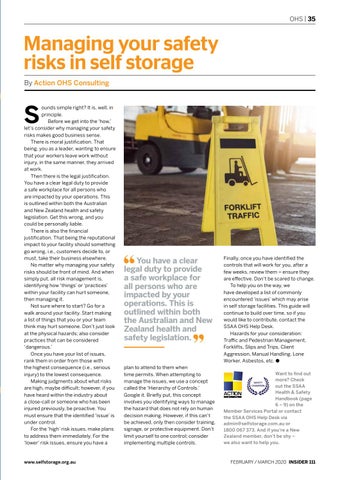OHS | 35
Managing your safety risks in self storage By Action OHS Consulting
S
ounds simple right? It is, well, in principle. Before we get into the ‘how,’ let’s consider why managing your safety risks makes good business sense. There is moral justification. That being, you as a leader, wanting to ensure that your workers leave work without injury, in the same manner, they arrived at work. Then there is the legal justification. You have a clear legal duty to provide a safe workplace for all persons who are impacted by your operations. This is outlined within both the Australian and New Zealand health and safety legislation. Get this wrong, and you could be personally liable. There is also the financial justification. That being the reputational impact to your facility should something go wrong, i.e., customers decide to, or must, take their business elsewhere. No matter why managing your safety risks should be front of mind. And when simply put, all risk management is, identifying how ‘things’ or ‘practices’ within your facility can hurt someone, then managing it. Not sure where to start? Go for a walk around your facility. Start making a list of things that you or your team think may hurt someone. Don’t just look at the physical hazards; also consider practices that can be considered ‘dangerous.’ Once you have your list of issues, rank them in order from those with the highest consequence (i.e., serious injury) to the lowest consequence. Making judgments about what risks are high, maybe difficult; however, if you have heard within the industry about a close-call or someone who has been injured previously, be proactive. You must ensure that the identified ‘issue’ is under control. For the ‘high’ risk issues, make plans to address them immediately. For the ‘lower’ risk issues, ensure you have a
www.selfstorage.org.au
You have a clear legal duty to provide a safe workplace for all persons who are impacted by your operations. This is outlined within both the Australian and New Zealand health and safety legislation.
plan to attend to them when time permits. When attempting to manage the issues, we use a concept called the ‘Hierarchy of Controls.’ Google it. Briefly put, this concept involves you identifying ways to manage the hazard that does not rely on human decision making. However, if this can’t be achieved, only then consider training, signage, or protective equipment. Don’t limit yourself to one control; consider implementing multiple controls.
Finally, once you have identified the controls that will work for you, after a few weeks, review them – ensure they are effective. Don’t be scared to change. To help you on the way, we have developed a list of commonly encountered ‘issues’ which may arise in self storage facilities. This guide will continue to build over time, so if you would like to contribute, contact the SSAA OHS Help Desk. Hazards for your consideration: Traffic and Pedestrian Management, Forklifts, Slips and Trips, Client Aggression, Manual Handling, Lone Worker, Asbestos, etc. l Want to find out more? Check out the SSAA Health & Safety Handbook (page 6 – 9) on the Member Services Portal or contact the SSAA OHS Help Desk via admin@selfstorage.com.au or 1800 067 373. And if you’re a New Zealand member, don’t be shy – we also want to help you.
FEBRUARY / MARCH 2020 INSIDER 111














